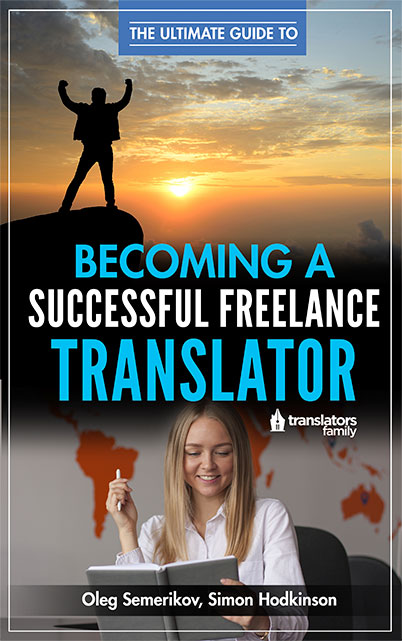[spacer height=”20px”]

This Summer I finally managed to read The Ultimate Guide to Becoming a Successful Freelance Translator, by Oleg Semerikov and Simon Hodkinson. Written by established translators, this book is directed at those wishing to build a career as independent translators. Whether you are a language student or an in-house translator wondering how to make it as a freelancer, this guide promises to “give you the best possible chance of success”. Throughout the book’s 176 pages, the authors share their knowledge and experience in the business, explaining how all of us can too have the best job in the world.
Not for everyone
Every experienced freelance translator is aware of the advantages and disadvantages of being self-employed. For the newbies, the idea of not commuting and not having a boss might sound appealing but the authors remind us of the downside of being independent. Freelancing is much less secure than working in-house, for instance. Also, social life can easily take a toll. So, before you commit, make sure to check back on your linguistic skills, on your ability to self-motivate, and your willingness to take it seriously.
[su_quote]Freelancing is an exciting adventure. It’s not for everyone – but for the right kind of person, it’s a dream come true![/su_quote]
We often hear that translators are shy and introverted. Even if that is the case for many, that can’t stop us from getting out there and marketing our services. Translators need to take active measures to be found by prospective clients. They need to convince clients they are professional. An online presence, a CV, and active marketing are just some basic items you need to tick on the list to getting started.
Relationships with clients
Having great translation skills is a must, of course, but those skills are only valuable if you have the clients to showcase them to. The authors advise translators not to disregard investment in long-term partnerships with their clients.
[su_quote][P]rofessionalism extends beyond your actual translations and includes – along with many other things – the way you relate to your clients.[/su_quote]
Here’s a summary of the main tips to keeping good relationships with clients:
- Communication: be prompt to answer emails; keep it clear and concise.
- Be friendly: make your clients feel at ease.
- Be proactive: e.g., by flagging errors in the source text to the client.
- Go above and beyond: apart from translation, can you provide additional services to the client?
- Market yourself: what is your USP? A specialization, proficiency with a particular type of software? Identify what makes you unique and market it to potential and current clients.
Money matters
At times it might feel like rates are on a race to the bottom and that it is impossible to make a living out of translation. Remember that those clients only pay low prices because some translators accept to work for little. Don’t sell yourself short.
[su_quote][F]ind out what the actual going rate is for someone with your language combination, skills and experience, and charge it.[/su_quote]
Yes, it is possible that agencies pay a bit less than direct clients, but don’t let that discourage you from working with them. Agencies can be a reliable source of income as they are always in need of translations. Also, there are plenty of translation agencies out there which value high-quality translators.
Good agencies care about their clients, but they also care about working with a reliable team of translators. Make sure communication is clear from the beginning of the relationship. Lay out your expectations and let them know your rates, payment terms, etc.
How much should you charge? You don’t want to alienate clients with rates that are too high, but you don’t want to charge too low and burn yourself up only to make ends meet either. The Ultimate Guide recommends translators consider their skillset when setting rates. Are your skills rare, hard to develop, or in demand? Can you handle DTP? How many words can you translate in a day? Also, how many hours do you want to work per day or week? Do the math and have all these aspects reflected in your rates.
Be resourceful
As translators work with words, glossaries, dictionaries, and other reference materials are instrumental resources to have. Being resourceful can improve translations’ quality and speed, regardless of years of experience. Whether you’re starting out and feel overwhelmed by the number of tasks you need to carry out, or you’re experienced and believe these materials won’t do much, you shouldn’t overlook the advantages they all have in today’s fast-moving language services market. Quality glossaries, translation memories, style guides, dictionaries, thesauri, and the like help linguists be consistent, by translating key terms and phrases the same way.
[su_quote]And the sooner you build up resources like these, the better your results will be – and the more they’ll improve over time as you expand and add to them.[/su_quote]
For online dictionaries, glossaries, thesauri, and other useful links check my Resources page.
The Ultimate Guide to Becoming a Successful Freelance Translator covers many other aspects of the translation business. It includes chapters on marketing, SEO for translators, different specializations (e.g., video game translation, literary translation), working as a digital nomad, a history of translation, among other topics. Overall, there is enough content in this e-book to cover all aspects of freelancing for translators. I found it particularly helpful for linguists starting out as freelancers. There is a lot of information out there, but this guide has it all packed in less than 200 pages.
If you are interested in reading this guide for translators, visit https://translatorsbook.com/.
[spacer height=”50px”]
